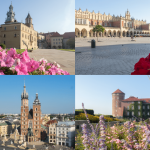Unlocking The Untold Stories: European Exploration Trade Routes Revealed – Embark On A Journey Of Discovery Now!
EuroTrip: Exploring the Trade Routes of Europe
Have you ever wondered how the world we live in today came to be? How different cultures and civilizations interacted and exchanged goods? Well, the key to understanding these questions lies in the European exploration trade routes. These routes played a crucial role in shaping the world we know today, facilitating the exchange of goods, ideas, and cultures between Europe and the rest of the world. Join me on a journey through time as we explore the fascinating world of European exploration trade routes.
Introduction to European Exploration Trade Routes
The European exploration trade routes refer to the networks of maritime and overland routes that European explorers used to expand their influence and seek new trade opportunities during the Age of Discovery. This era, spanning from the 15th to the 18th century, witnessed a surge in European exploration, with renowned explorers such as Christopher Columbus, Vasco da Gama, and Ferdinand Magellan leading expeditions to unknown lands.
3 Picture Gallery: Unlocking The Untold Stories: European Exploration Trade Routes Revealed – Embark On A Journey Of Discovery Now!



The primary goal of these explorers was to find new trade routes to access valuable resources such as spices, silk, and precious metals. The European powers of the time, including Portugal, Spain, England, and the Netherlands, competed fiercely to establish dominance over these trade routes, resulting in a fierce struggle for control and influence in different parts of the world.
The Who, When, Where, Why, and How of European Exploration Trade Routes

Image Source: worldhistory.org
Who: European powers such as Portugal, Spain, England, and the Netherlands were the primary players in European exploration. However, explorers from other countries, including France and Italy, also made significant contributions.
When: The European exploration trade routes thrived during the Age of Discovery, from the 15th to the 18th century. This period marked a significant shift in world history, as Europeans ventured into uncharted territories and established global trade networks.
Where: European explorers ventured into various parts of the world, including Africa, Asia, and the Americas. Their expeditions opened up new trade routes that connected Europe to these regions, leading to the establishment of colonies and the exchange of goods.

Image Source: britannica.com
Why: The main motivations behind European exploration were economic gain, the desire to spread Christianity, and the quest for political power. European powers saw the potential for wealth and influence in distant lands, and they sought to exploit these opportunities through trade and colonization.
How: European explorers relied on advancements in navigation technology, such as improved ship designs, navigational instruments like the compass and astrolabe, and the mapping of wind patterns. These innovations enabled them to navigate the treacherous seas and reach distant lands previously unknown to Europeans.
Frequently Asked Questions about European Exploration Trade Routes
Q: What were some of the major European exploration trade routes?

Image Source: kajabi-cdn.com
A: Some of the major trade routes include the Silk Road, the Spice Route, the Transatlantic Slave Trade route, and the Cape Route.
Q: Which European country dominated the exploration trade routes?
A: Portugal emerged as an early leader in exploration, establishing trading posts and colonies along the coasts of Africa, India, and Brazil. However, other European powers later challenged Portuguese dominance.
Q: What were the consequences of European exploration trade routes?
A: The consequences of these trade routes were far-reaching. They led to the exchange of goods, ideas, and cultures between Europe and the rest of the world, triggering the process of globalization. However, they also resulted in the exploitation and colonization of indigenous peoples and the decimation of local economies and ecosystems.
Exploring the Routes: The Type, Size, and Material
European exploration trade routes consisted of both maritime and overland routes. The maritime routes involved long-distance sea voyages, with ships carrying goods and explorers. These routes were crucial for connecting Europe to distant lands, such as India, China, and the Americas.
The size of the ships used in these voyages varied depending on the purpose and destination. Some expeditions required large, heavily armed vessels capable of withstanding harsh ocean conditions, while others utilized smaller, faster ships for coastal navigation and exploration.
The materials used in shipbuilding evolved over time. Initially, European ships were made of wood, typically oak or pine. However, as exploration continued and knowledge of shipbuilding improved, ships were constructed using stronger and more durable materials, such as teak and mahogany.
Pros and Cons of European Exploration Trade Routes
European exploration trade routes brought both benefits and drawbacks to the world. On the positive side, they facilitated the exchange of goods, leading to the emergence of a global economy. They also sparked an era of innovation and scientific advancements, as European explorers brought back new ideas, technologies, and knowledge from their expeditions.
However, the trade routes also had negative consequences. The colonization and exploitation of indigenous peoples led to the loss of lives, cultures, and resources. The introduction of new diseases to previously isolated populations caused devastating epidemics. Additionally, the environmentally destructive practices associated with resource extraction and trade disrupted local ecosystems.
Conclusion: Uncovering the Legacy of European Exploration Trade Routes
The European exploration trade routes played a pivotal role in shaping the modern world. They connected distant lands, fostered cultural exchanges, and transformed global economies. However, the legacies of these routes are complex, encompassing both triumphs and tragedies.
As we reflect on the impact of European exploration trade routes, we must recognize the importance of understanding history from multiple perspectives. By examining both the benefits and costs of these routes, we can gain a more comprehensive understanding of our shared past and work towards a more inclusive and equitable future.
This post topic: Travel

